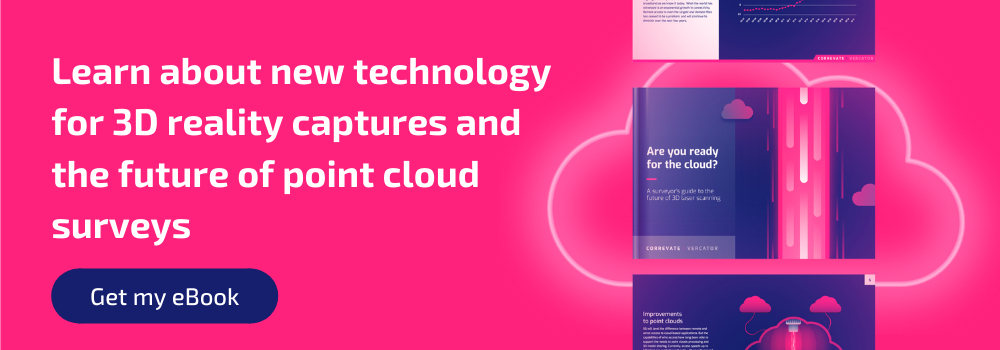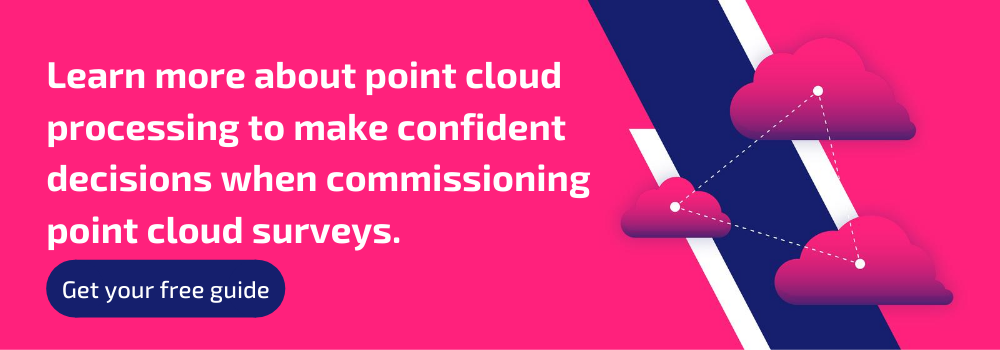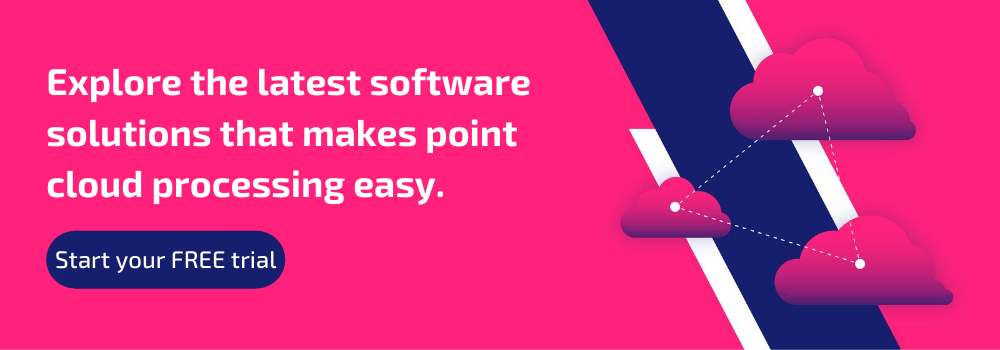The cost of commissioning a 3D point cloud survey: 4 things you need to know when speaking with surveyors

Undertaking a point cloud survey can be a complex process involving precision and expertise, usually requiring the skills of trained and experienced professionals. The cost of commissioning such a survey is normally tied to the amount of time it takes -- with charges starting at around £1000 per day.
So, how do you get the best service and the best price?
When dealing with laser scanning specialists such as surveyors, it is important to be able to discuss “the art of the possible" and understand the subsequent cost implications and trade-offs. Having some clarity and insight into the technical constraints faced by surveyors when creating point cloud data will help you agree on the best and most cost-effective outcome.
Here are the 4 things you need to know before speaking with a surveyor to commission a 3D point cloud scan for digital modelling.
1. Not all point cloud surveys need to deliver the same level of detail
The detail contained within a point cloud survey is directly tied to point density. The precision of the measurements that you can make from a point cloud is limited to the distance between the points. You need to understand project requirements and perform a scan that is suited to that margin for error.
It’s always important to consider what will be the future and potential use of the deliverables to be produced. You may intend to use the point cloud to pick out finer detail, maybe to establish the positions of industrial fixtures or architectural detailing. You should then discuss the point density you require for the survey.
However, you do not want to go overboard. More highly dense point clouds will take longer to create and process, resulting in larger files which are likely to be more expensive to commission.
For example, to ensure 10mm accuracy, each scan could take about 1 minute to capture, whereas to capture 1mm or lower may require more than 10 minutes per scanned position. If your scan set runs into the hundreds or thousands, the time taken on site to carry out laser scanning can add up significantly. These same scans will then take longer to process and register too.
When commissioning a point cloud, the first rule is to be clear on your requirements. Unless you explain the purpose of the survey and it is well understood, vital information can be missed. It may also mean that the accuracy required isn't met, which can turn into increased costs later during the construction phase. Discuss the external form, interior spaces, extensions, the presence of complex details. These are all factors that will affect the cost of laser scanning and other survey activities.
Is colour needed for your 3D model?
Using a 3D laser scanner with an integrated digital camera allows information to be captured about colour and material. The acquisition of this type of information lengthens the time of data acquisition and post-processing with a consequent increase of costs. If you consider that a typical scan might require approximately 3.5 minutes on site and more time in the office processing the data, requesting a full-colour point cloud can increase the cost of the survey by around 40%.
2. Levels of accuracy – beware propagation error
A point cloud can be made up of hundreds, sometimes thousands of individual scan positions. The scanner creates an individual piece of the point cloud from each of the scanned positions, these pieces must be placed together to create the finished product. If this isn't done correctly, it can lead to compounded errors in the survey and bring about the risk of further errors throughout the design process.
This propagation error is an inherent issue that stems from the other source of inherent error — scanner limitations. When building a composite point cloud, scans are effectively built on top of each other, all rooting back to a single ‘home’ scan. The more ‘steps’ between any given scan and its ‘home’ scan, the greater propagation error it will suffer.
Propagation errors can never be removed. The compounding of errors is an inherent aspect of physical reality. However, it can be minimised. What surveyors need is the ability to limit the number of steps of scans from the ‘home’ scan.
This can be minimised by quality processing software. For example, advanced, vector-based, multi-stage processing software can deliver cloud-to-cloud alignments with overlaps in the 30% range – meaning less scans and less steps.
If scan sets are too large, the creation of a site grid using a total station might need to be undertaken. This is another time-consuming process that will drive up costs. However, if it is necessary, it is an expense that has to be accommodated.
3. Registration is one of the most time-consuming aspects of delivering the final point cloud survey
The process of accurately aligning the multiple scans required to cover a scene, as described earlier, is called 'registration'. This is actually one of the most time-consuming aspects of creating a finished point cloud. A significant amount of what you pay for in commissioning a point cloud can be attributed to the time it takes to register the scans.
To deliver this, surveyors traditionally take two different approaches, the use of field targets or targetless registration techniques that rely on algorithms and the cross-identification of natural features within scan overlaps.
Targets can be free-standing spheres or chequerboard surface targets. By overlapping adjacent scans so that each share common targets, scans can be ‘fixed’ in context. By overlaying common targets, multiple scans can be accurately combined to create a complete and precise map.
This is a reliable and robust method for overcoming the task of point cloud registration. The problem is that it is time-consuming to place sufficient targets in the right place.
The idea behind ‘targetless registration’ is reasonably simple: rather than using artificial targets, the use of common natural features to contextually ‘fix’ adjacent scans. Each scan already holds highly detailed information. If it can be appropriately assessed, that data is more than sufficient to align overlapping scans with the same level of precision that each possesses independently.
Dispensing with the need to use ‘registration’ targets is the holy-grail of point cloud generation. It can deliver a simplified and streamlined process for mapping 3D space. But the concern is that the time-consuming element of target placement is substituted by computer programs that need supervision and manual checking to complete the process. This is an area where looking for innovative solutions deployed by surveyors will pay off. Innovation in this area is beginning to have a profound effect on the cost profile of point cloud processing.
4. Advances in point cloud processing deliver greatly reduced costs
The key development to be aware of, when looking at practical targetless registration is in the use of automated, point cloud processing software. The use of software exploiting advances in machine learning and ‘vector analysis’ has removed manual processes during the registration of targetless scans, and accelerated the entire process.
This approach drastically reduces the time spent processing and automates procedures by breaking apart the registration process into three distinct stages: rotational, horizontal and vertical alignments.
The greater simplicity of each of these three stages allows each to be approached more thoroughly, with greater automation and at greater speed. This even enables a decrease in the required scan overlap for targetless registration alignment to as little as 30% in distinct environments – and less scans mean less cost.
A 28 scan dataset, for example, will benefit from around a 75% reduction in processing time, allowing it to be completed in about an hour. Most large-scale projects will benefit from a 40%-80% reduction in processing time. This scales down in efficiency as datasets grow in size. However, because the total time increases, the benefit large projects receive from avoiding manual involvement grows. This greatly expands the efficiency with which surveyors can do their job.
There is always a balance between traditional and innovative methods in a rapidly evolving marketplace such as this. Finding a surveyor who understands and makes best use of such innovative technology will have a major impact on time and hence cost. Not necessarily getting the cheapest solution, but certainly the most appropriate and best fit to your needs.
Tags: point clouds



